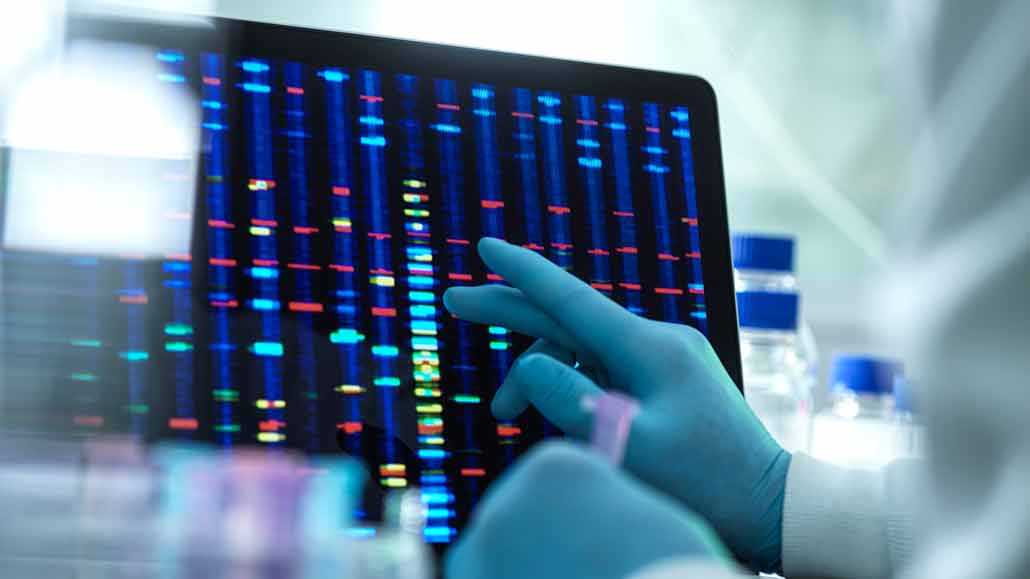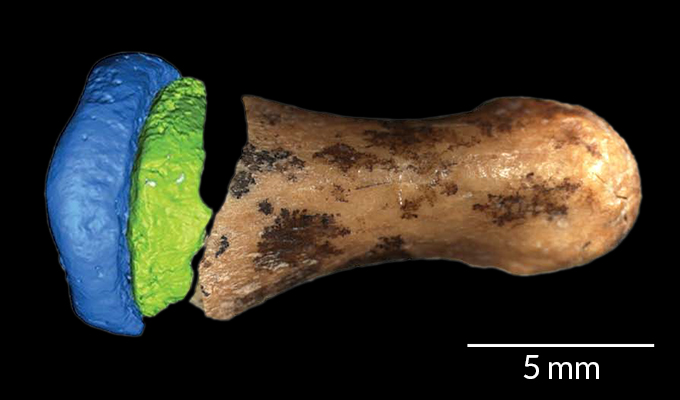Genetics show humans likely trace back to Africa
But many of our ancestors picked up new DNA on their travels across time and continents

High-tech tools allow scientists to identify the makeup of genes in a sample of DNA, as seen here. Such analyses have been recently begun helping anthropologists home in on where humans and their cousins evolved — and how closely related their species are.
Tek Image/Science Photo Lib./Getty Images Plus
By Erin Wayman
For centuries, the study of human origins relied on fossils. Scientists wanted to know from which species Homo sapiens descended and to which we were most closely related. For answers, they could do little more than compare the size, shape and orientation of preserved bones and teeth — perhaps along with tools and other artifacts. That all changed by the 1980s.

To celebrate its 100th anniversary, Science News is highlighting some of the biggest advances in science over the last century. To see an expanded version of this story and more from the series, visit Century of Science.
Scientists started looking at the DNA of people alive today as a way to understand our past. Then in the 1990s, genetics pulled off a feat straight out of science fiction: It decoded the DNA preserved in the fossils left by our ancient ancestors.
It was a pivotal change in the study of human evolution, notes John Hawks. He’s a paleoanthropologist. He works at the University of Wisconsin–Madison. That ancient DNA, he says, began revealing things no one had even thought to look for.
DNA started offering clues about our evolution in 1987.
That’s when researchers at the University of California, Berkeley analyzed DNA from people living around the world. They focused on what’s known as mitochondrial DNA. Children inherit this mtDNA from their mothers. It undergoes no genetic reshuffling. So mtDNA preserves a mother’s ancestry going back millennia.
African populations showed the greatest genetic diversity in mtDNA. And when the Berkeley team built a family tree using their genetic data, it contained two main branches. One held only African lines. The other contained lineages from all over the world, including Africa.

Educators and Parents, Sign Up for The Cheat Sheet
Weekly updates to help you use Science News Explores in the learning environment
Thank you for signing up!
There was a problem signing you up.
Searching for a Garden of Eden
This suggested the “mother” lineage for them all had come from Africa.
Based on the estimated rate at which mtDNA changes over time, the team calculated that this African Eve must have lived some 200,000 years ago. It reported its conclusions in Nature.
But not everyone interpreted the genetic evidence the same way. Some argued that perhaps African populations in the distant past had been much larger than other ancient groups. Maybe that’s why the African mtDNA appeared dominant. Also, they noted, mtDNA isn’t a complete record of inheritance. It doesn’t, for instance, show dads’ genes.
Year by year, ever more data accumulated. With each new dating technique used and each discovery unveiled, the idea as Africa as the source of human evolution only strengthened.
Our species is Homo sapiens. In 2003, fossil evidence would suggest the earliest fossil sites for this species were in Ethiopia. They dated to between 195,000 and 160,000 years ago. More recently, scientists linked roughly 300,000-year-old fossils in Morocco to our species.
Another genetic window into our collective past opened in 1997. That’s when researchers recovered mtDNA from a Neandertal fossil. Leading the team was Svante Pääbo. He’s a geneticist now at the Max Planck Institute for Evolutionary Anthropology. It’s in Leipzig, Germany. This mtDNA was so different from any modern human’s that it suggested Neandertals must be a separate species.

A decade later, Pääbo was part of a team that assembled the Neandertal’s genetic blueprint, or genome. They compared it with DNA from modern humans. And this led to a startling conclusion: About 1 to 4 percent of DNA in non-Africans today traces back to Neandertals.
Those data seemed to revise the model for human origins. Yes, the new idea went, we originated in Africa. But once our ancestors expanded into new places, some mated with other hominins (closely related species that are now extinct). Hints of such hybrids were reported in the late 1990s. That’s when some researchers claimed an ancient skeleton from Portugal had a mix of Neandertal and human features.
Pääbo’s group also analyzed DNA from a finger bone found at Siberia’s Denisova Cave. Both Neandertals and modern humans had once lived there. But the DNA from fossils in this cave didn’t match either group. The genetics revealed a new hominin. These folk, now known as Denisovans, remain mysterious. They are known from only a few bits of bone and teeth. But they, too, interbred with humans. For instance, Denisovan DNA accounts for about 2 to 4 percent of the DNA in people native to some Southwest Pacific island nations.
Fossil and genetic evidence seem to suggest that throughout time and across continents, groups of human ancestors mated with other groups. The groups came from different lands and likely looked different from one another. Some researchers think that the sharing of genes through this mixing enabled ancient folks across Africa, Asia and Europe to stay a unified species. And this species gradually evolved into what we think of as modern humans. Yes, these researchers say, there may have been some substantial regional variations in skin color, eye colors and more. But the underlying species everywhere were now the same: human.







